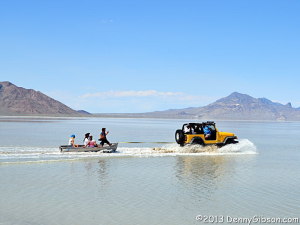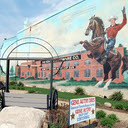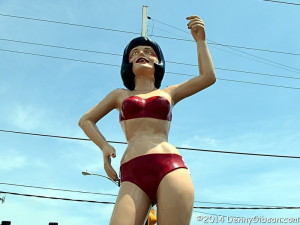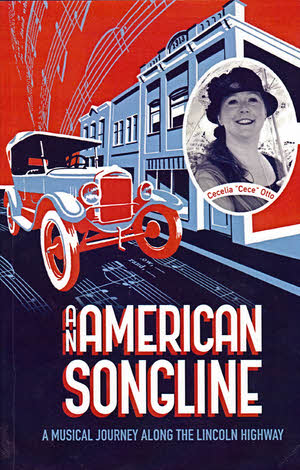 Cece’s a singer… and a traveler and now a writer. Cece (I know the book cover says Cecelia but few actually call her that.) has been singing since childhood. As an adult, she has spent a goodly amount of time singing professionally as a classically trained mezzo-contralto and there was travel, both in and out of the US, involved. Then, just as the career should have been accelerating, a stumbling economy resulted in it instead being sort of paused. Cece used the time to attend workshops and other activities to help in focusing her future. One workshop involved identifying, in a short amount of time, “…five projects you see yourself doing…” and one item on her hurriedly produced list was “singing travelogue”. No one, including Cece, was quite sure what that meant but it sounded intriguing and, before long, she was on her way to defining a real world project that included a coast-to-coast concert tour, a CD, and this book.
Cece’s a singer… and a traveler and now a writer. Cece (I know the book cover says Cecelia but few actually call her that.) has been singing since childhood. As an adult, she has spent a goodly amount of time singing professionally as a classically trained mezzo-contralto and there was travel, both in and out of the US, involved. Then, just as the career should have been accelerating, a stumbling economy resulted in it instead being sort of paused. Cece used the time to attend workshops and other activities to help in focusing her future. One workshop involved identifying, in a short amount of time, “…five projects you see yourself doing…” and one item on her hurriedly produced list was “singing travelogue”. No one, including Cece, was quite sure what that meant but it sounded intriguing and, before long, she was on her way to defining a real world project that included a coast-to-coast concert tour, a CD, and this book.
The word “songline” was already part of her vocabulary. Songlines, or dream-tracks, are paths across Australia that indigenous people navigate, and have navigated for centuries, by the singing of songs.The songs are a mix of geography, mythology, and history and that sounds a lot like a “singing travelogue”. Cece chose the Lincoln Highway as the path for her “singing travelogue”. She traveled it during its centennial in 2013 with performances along its entire length. Unlike the Australian songlines, there isn’t really a song or even a set of songs that will guide travelers along the Lincoln Highway but Cece compiled a repertoire of tunes that mention the highway or were performed along it during its 1913-1928 heyday. Some new original Lincoln Highway related songs appeared in her concerts, too.
At one level, the book is a travelogue of that 2013 trip from New York City to San Francisco. Multiple outings are spread over six months. There are descriptions and photos of the same roadside attractions and interesting people and places that folks on vacation might encounter because, when possible, Cece is a tourist enjoying the sights. But sightseeing is definitely secondary. The purpose of the trip is the series of concerts and getting to each of them and being healthy when she gets there is her primary focus. Therefore, the book is also — perhaps mostly — a behind the scenes story of a do-it-yourself solo concert tour. Of course, getting to and performing concerts involves interesting people and places, too.
The book’s organization basically follows the road with states that the Lincoln Highway passes through providing most chapter names. Two notable exceptions are “Loss Along the Lincoln Highway”, which talks about events and thoughts that have absolutely nothing to do with geography, and “Love Along the Lincoln Highway”, in which Cece’s husband, Dan, shares his thoughts on the project that separated the recently wed couple for extended periods. The “singing travelogue” concept is brought to the printed page by beginning each chapter with the description of one of the songs from the tour.
An American Songline has plenty of dates and places and people but it also has emotions. Not only does Cece describe towns and venues, she shares the feeling of singing in those venues when she hasn’t seen her husband in a month and she talks about performing when the recent death of a friend is on her mind and after being surprised by a familiar but unexpected face in the audience. Being behind the scenes sometimes gets personal.
As a sort of “full disclosure”, I’ll mention that I first met Cece at the 2011 Lincoln Highway Association Conference when An American Songline was still a dream. I saw her perform at the concert in Hayseville, Ohio, as well as at other LHA events including the centennial in Kearney, Nebraska. Like Cece, I headed west from Kearney and, although I did not attend the advertised concert, spotted her name in lights along the way. I took some pictures but have never had an opportunity to use them… until now.
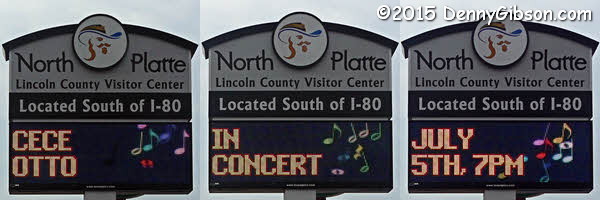
An American Songline website.
An American Songline: A Musical Journey Along the Lincoln Highway, Cecelia Otto, CreateSpace Independent Publishing Platform, June 11, 2015, paperback, 8 x 5.2 inches, 318 pages, ISBN 978-1514317822
Available through Amazon.
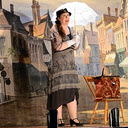 This picture is from my 2013 American Songline in Hayesville trip. During the Lincoln Highway’s centennial, singer Cece Otto performed a series of concerts along the highway including one at the historic opera house in Hayseville, Ohio. I centered a three day trip around the concert by preceding it with a Carey Murdock concert in Van Wert, Ohio, and following it with a visit to the Columbus Zoo. Cece documented her centennial concerts with a 2015 book which I reviewed here.
This picture is from my 2013 American Songline in Hayesville trip. During the Lincoln Highway’s centennial, singer Cece Otto performed a series of concerts along the highway including one at the historic opera house in Hayseville, Ohio. I centered a three day trip around the concert by preceding it with a Carey Murdock concert in Van Wert, Ohio, and following it with a visit to the Columbus Zoo. Cece documented her centennial concerts with a 2015 book which I reviewed here.
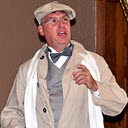
 In its preface, Lyell D. Henry Jr. suggests that this book is something of a compromise. The reason is that he once set out to write about every detail of the Jefferson Highway and the association behind it. That’s a lot of details and, especially with no known central source for records or maps, a formidable task. Henry says he “…settled on writing a book that would open with a general accounting of JHA’s early pursuit of the entire highway but then narrow its focus to the highway through Iowa.” The Jefferson Highway: Blazing the Way from Winnipeg to New Orleans is indeed a book of two parts. The first four chapters cover the history of the organization responsible for the entire highway; The last three tell the story and describe the route of the road in Iowa. The scale may be less and the focus may be narrower than what Henry once had in mind but, within that narrowed focus, there is certainly no detectable compromising of accuracy or completeness.
In its preface, Lyell D. Henry Jr. suggests that this book is something of a compromise. The reason is that he once set out to write about every detail of the Jefferson Highway and the association behind it. That’s a lot of details and, especially with no known central source for records or maps, a formidable task. Henry says he “…settled on writing a book that would open with a general accounting of JHA’s early pursuit of the entire highway but then narrow its focus to the highway through Iowa.” The Jefferson Highway: Blazing the Way from Winnipeg to New Orleans is indeed a book of two parts. The first four chapters cover the history of the organization responsible for the entire highway; The last three tell the story and describe the route of the road in Iowa. The scale may be less and the focus may be narrower than what Henry once had in mind but, within that narrowed focus, there is certainly no detectable compromising of accuracy or completeness. Cece’s a singer… and a traveler and now a writer. Cece (I know the book cover says Cecelia but few actually call her that.) has been singing since childhood. As an adult, she has spent a goodly amount of time singing professionally as a classically trained mezzo-contralto and there was travel, both in and out of the US, involved. Then, just as the career should have been accelerating, a stumbling economy resulted in it instead being sort of paused. Cece used the time to attend workshops and other activities to help in focusing her future. One workshop involved identifying, in a short amount of time, “…five projects you see yourself doing…” and one item on her hurriedly produced list was “singing travelogue”. No one, including Cece, was quite sure what that meant but it sounded intriguing and, before long, she was on her way to defining a real world project that included a coast-to-coast concert tour, a CD, and this book.
Cece’s a singer… and a traveler and now a writer. Cece (I know the book cover says Cecelia but few actually call her that.) has been singing since childhood. As an adult, she has spent a goodly amount of time singing professionally as a classically trained mezzo-contralto and there was travel, both in and out of the US, involved. Then, just as the career should have been accelerating, a stumbling economy resulted in it instead being sort of paused. Cece used the time to attend workshops and other activities to help in focusing her future. One workshop involved identifying, in a short amount of time, “…five projects you see yourself doing…” and one item on her hurriedly produced list was “singing travelogue”. No one, including Cece, was quite sure what that meant but it sounded intriguing and, before long, she was on her way to defining a real world project that included a coast-to-coast concert tour, a CD, and this book.


 Sometimes hordes of fans demand an e-book version of a publication which prompts the publisher to pull out all the stops and produce one immediately. Sometimes one or two people casually ask about an e-book version and probably forget about it by the time one appears a year or so later. One of these sentences describes my situation perfectly.
Sometimes hordes of fans demand an e-book version of a publication which prompts the publisher to pull out all the stops and produce one immediately. Sometimes one or two people casually ask about an e-book version and probably forget about it by the time one appears a year or so later. One of these sentences describes my situation perfectly.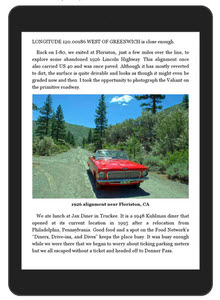 Other than correcting a couple of spelling errors, absolutely no text was changed in generating the e-book. The same pictures are in the e-book as in the paperback with essentially the same dimensions. I did utilize color versions so they ought to look a little prettier on some devices. To make things reflowable, I unhooked the pictures and their captions from fixed positions on the pages and placed them between paragraphs. If you think of the sizing and positioning of a book’s non-text elements within the text as design, then what I did was undesign the book. To be honest, there wasn’t very much “design” in it. I placed pictures where I thought they looked good and I chose sizes to spotlight those I particularly liked or to allow some to be grouped together. Design is too kind a word. At best what I did was layout. I arranged some block images so that they looked alright, appeared near any text that referenced them, and didn’t disrupt that text too much. But other books truly are designed and their designers agonize over scaling and placing elements so that a page — a physical page with fixed dimensions — looks good and works well. That sort of design is no better accommodated in the e-reader world than my clunky picture layouts.
Other than correcting a couple of spelling errors, absolutely no text was changed in generating the e-book. The same pictures are in the e-book as in the paperback with essentially the same dimensions. I did utilize color versions so they ought to look a little prettier on some devices. To make things reflowable, I unhooked the pictures and their captions from fixed positions on the pages and placed them between paragraphs. If you think of the sizing and positioning of a book’s non-text elements within the text as design, then what I did was undesign the book. To be honest, there wasn’t very much “design” in it. I placed pictures where I thought they looked good and I chose sizes to spotlight those I particularly liked or to allow some to be grouped together. Design is too kind a word. At best what I did was layout. I arranged some block images so that they looked alright, appeared near any text that referenced them, and didn’t disrupt that text too much. But other books truly are designed and their designers agonize over scaling and placing elements so that a page — a physical page with fixed dimensions — looks good and works well. That sort of design is no better accommodated in the e-reader world than my clunky picture layouts.

